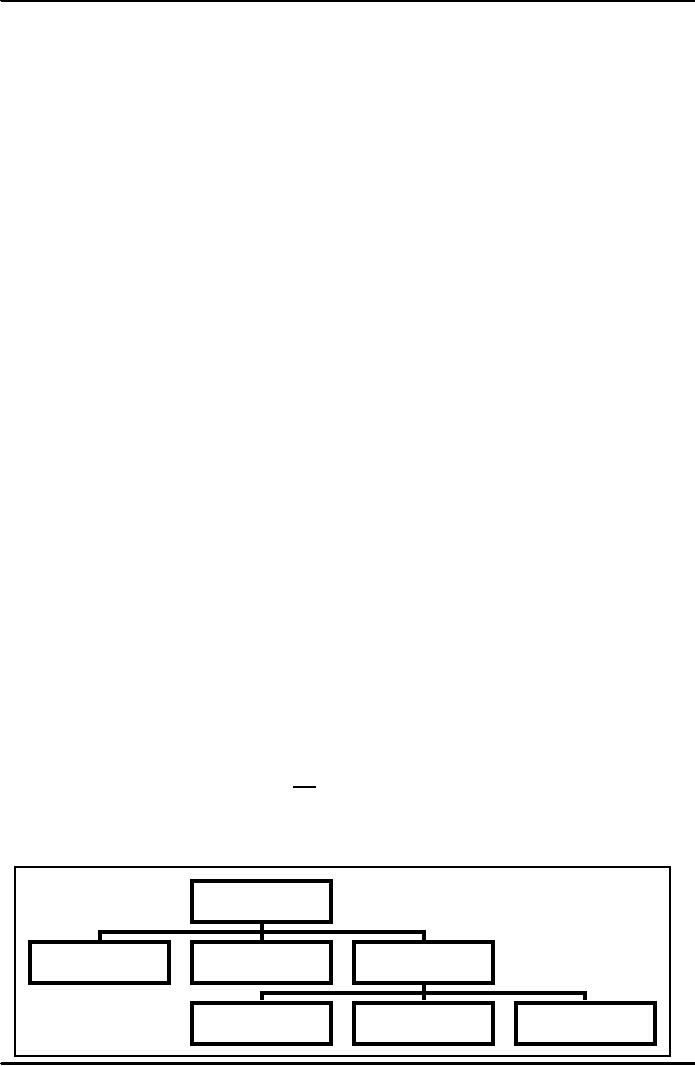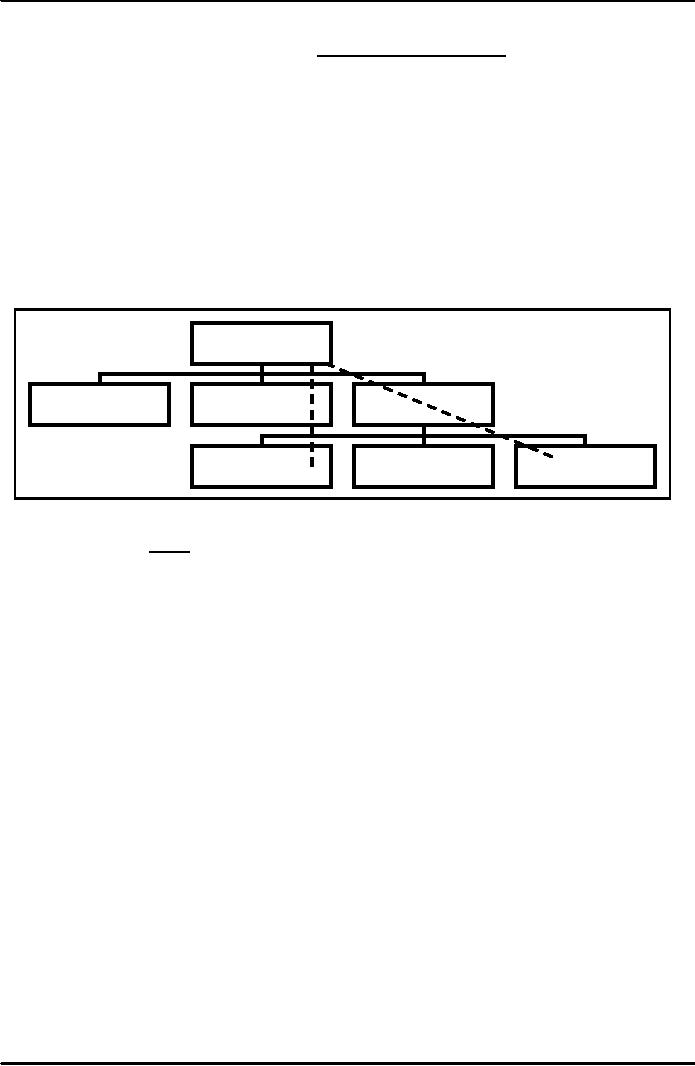 |

Introduction
To Public
AdministrationMGT111
VU
LESSON
16
POWER
AND AUTHORITY
At the
end of the lecture students
will be able to
understand:
·
The
concepts of Line and
Staff
·
Relationship
of authority with line and
staff concept
·
Centralization,
Decentralization and Delegation
Definition
of Power and Authority
Authority
is a force for achieving desired
outcomes, but only as
prescribed by the formal
hierarchy
and reporting
relationships,
Authority
is vested in organizational positions, not
because of the personalities and
personal
characteristics
of the individuals, but because of the
position that a person is
holding.
Power
is the ability to influence others to
modify behaviour to achieve stated
objectives.
Authority
is also defined as the right in a
position to exercise discretion in making
decisions affecting others.
Line
and Staff Concept
There
is much confusion on what exactly is
"line" and "staff" in
management literature and
practice.
But line and staff relationship
are important as an organizational way of
life and authority
relationship.
Line
Concept
Line
functions are those that
have direct impact on the accomplishment
of the objectives of an
organization.
Example: policeperson controlling the
mob
Staff
Concept
Staff
functions are those that
help the line persons work
most effectively in accomplishing
the
objectives.
Example: A person managing the budget of the
organization
Delegation:
It
is the assignment to another person of
formal authority (legitimate power) and
responsibility for
carrying
out specific activities
Nature
of Relationship
Scalar
Principle
The
clearer the line of authority
from the ultimate management position in
an organization to
every
subordinate position, the clearer will be
the responsibility for decision making
and effective will be
organization
communication. In many large
organizations the steps are
long and complicated. It
should
become
clear from the scalar
principle that line
authority is that relationship in which
superior exercises
direct
supervision over subordinate. In Figure 1 this
relationship is shown by the solid line
that connects
boxes.
Scalar
Principle
Figure
1
Chief
Executive
Managing
Managing
Managing
Director
Research
Director
Production
Director
Public
Manager
Purchase
Manager
Personnel
Manager
Factory
59

Introduction
To Public
AdministrationMGT111
VU
Functional
Authority
It
is important to understand the functional
authority. It is the right that is
delegated to an
individual
or a department to control specified
processes, practices, policies, or
other matters relating to
activities
undertaken by persons in other
departments. If principle of unity of
command were
followed,
authority
over these activities would be
exercised by their line
supervisor.
Delegation
of Functional Authority
One
can better understand Delegation of
functional authority as a small
slice of the authority of
line
supervisor. The Chairman or
head of institution has
complete authority to manage
organization, under
the
rules of organization. In pure staff situation the
advises on personnel, accounting,
purchasing etc., have
no
part of this line authority,
their duty is to offer
advise. But when the head of
institution delegates
his
advisor
to issue instructions to the line organization as
shown in figure-2 that is
called "functional
authority".
Scalar
Principle
Figure-
2
Chief
Executive
Managing
Managing
Managing
Director
Research
Director
Production
Director
Public
Manager
Purchase
Manager
Personnel
Manager
Factory
Benefits
of Staff
Today,
staff advice is far more critical
for business, government, and
other enterprises than it
was
in
the past. Operating managers are
now faced with making
decisions that require expert knowledge
in
economics,
technical political and
legal areas.
Another
major advantage of staff is that the
specialists may be given time to think,
to gather data,
and
to analyze to advise superiors,
whereas busy mangers cannot do
this. It is rare that operating
managers
will
find time to do analysis which the staff
assistant can do as well.
Limitations
of Staff
1.
Danger
of undermining Line Authority:
The advice of staff officers is taken by
the
executive
with enthusiasm which may
not be acceptable to line (operating)
people because
they
think that staff has no
experience of work of line
people.
2.
Lack
of Staff Responsibility: advisory departments
only propose plans while
line has to
implement.
When there is problem in the
implementation of plans the blame is
shifted to
those
who have advised. This
creates situation for
shifting blames for mistakes
on staff.
3.
Thinking
in a Vacuum: Because staff people do not implement.
They only advise so
what
they
advise they are blamed for
thinking in vacuum
Decentralization
of Authority
We
focussed on the kinds of authority relationship,
such as line staff and
functional authority.
Now
we
will look at dispersion of
authority.
Nature
of Decentralization
Organization
authority is given to people to use judgment to
make decision and give
instructions.
Decentralization
is the tendency to disperse
decision-making authority in an organized
structure. It
is
a fundamental aspect of delegation; to the extent
authority is not delegated, it is
centralized. How much
60

Introduction
To Public
AdministrationMGT111
VU
should
authority be concentrated in or dispersed
through out the organization? There could
be absolute
centralization
of authority in one person,
but that means no subordinate
mangers and therefore, no
structured
organization. Some decentralization exists in
all organizations & that is
shown in figure 3.
The
degree
of centralization and decentralization would vary
from organization to organization.
Figure-3
Complete
decentralization
Complete
centralization
(No
organizational structure)
(No
organizational structure)
Authority
Delegated
Authority
not delegated
Centralization
and Decentralization: The degree to
which formal authority is
delegated by manager
throughout
the organization runs along continuum
from centralization to decentralization as shown
in
figure
3. In a relatively decentralized organization,
considerable authority and responsibility
is passed down
the
organizational hierarchy
Different
Kinds of Centralization
1.
Centralization
of performance
2.
Departmental
centralization
3.
Centralization
as an aspect of Management
1.
Centralization of performance
It
pertains to geographic concentration; it
characterizes an organization operating in a
single
location
2.
Departmental centralization
It
refers to centralization of specialized
activities, generally in one department.
For example,
maintenance
for a whole plant may be
carried out by a single
department.
3.
Centralization as an aspect of
management
It
is the tendency to restrict delegation of
decision making. A high
degree of authority is held at
or
near the top by managers in the
hierarchy.
We
have so far covered four
building blocks of Organizing. These
are:
1.
Classify
work into activities which is called
`Division of labour
2.
Combine
activities in a logical and efficient
manner called
`Departmentalization'
3.
Specify
who reports to whom called
`Hierarchy'
4.
Integrate
departmental activities called
`coordination'
61

Introduction
To Public
AdministrationMGT111
VU
Concepts
Line
function:
functions
that have direct impact on the
accomplishment of
objectives
of organization
Staff
Function:
are
advisory functions. Staff people help
line persons to work
most
effectively in accomplishing
objectives.
Scalar
principle:
the
line of authority that
determines the relationship
between
supervisors
and supervised
Functional
authority:
authority
given to department or individual to control
specified
processes,
practices and
policies
Delegation
of authority:
giving
of part of authority to lower
level
Decentralization
of authority: decentralization of
authority is dispersion of decision
making
authority
in an organized structure.
62
Table of Contents:
- INTRODUCTION:Institutions of State, Individualism
- EVOLUTION OF PUBLIC ADMINISTRATION:Classical School, The Shovelling Experiment
- CLASSICAL SCHOOL OF THOUGHTS – I:Theory of Bureaucracy, Human Relation Approach
- CLASSICAL SCHOOL OF THOUGHTS – II:Contributors of This Approach
- HUMAN RELATIONS SCHOOLS:Behavioural School, System Schools
- POWER AND POLITICS:Conflict- as Positive and Negative, Reactions of Managers, Three Dimensional Typology
- HISTORY OF PUBLIC ADMINISTRATION – I:Moghul Period, British Period
- HISTORY OF PUBLIC ADMINISTRATION – II
- CIVIL SERVICE:What are the Functions Performed by the Government?
- CIVIL SERVICE REFORMS:Implementation of the Reforms, Categories of the Civil Service
- 1973 CONSTITUTION OF PAKISTAN:The Republic of Pakistan, Definition of the State
- STRUCTURE OF GOVERNMENT:Rules of Business, Conclusion
- PUBLIC AND PRIVATE ADMINISTRATION:The Public Interest, Ambiguity, Less Efficient
- ORGANIZATION:Formal Organizations, Departmentalization
- DEPARTMENTALIZATION:Departmentalization by Enterprise Function, Departments by Product
- POWER AND AUTHORITY:Nature of Relationship, Delegation of Functional Authority
- DELEGATION OF AUTHORITY:The Art of Delegation, Coordination
- PLANNING – I:Four Major Aspects of Planning, Types of Plans
- PLANNING – II:Planning ProcessThree principles of plans
- PLANNING COMMISSION AND PLANNING DEVELOPMENT:Functions, Approval Authority
- DECISION MAKING:Theories on Decision Making, Steps in Rational Decision Making
- HUMAN RESOURCE MANAGEMENT (HRM):Importance of Human Resource, Recruitment
- SELECTION PROCESS AND TRAINING:Levels at Which Selection takes Place, Training and Development
- PERFORMANCE APPRAISAL:Formal Appraisals, Informal Appraisals
- SELECTION AND TRAINING AND PUBLIC ORGANIZATIONS:Performance Evaluation,
- PUBLIC FINANCE:Background, Components of Public Finance, Dissimilarities
- BUDGET:Components of Public Income, Use of Taxes, Types of Taxation
- PUBLIC BUDGET:Incremental Budget, Annual Budget Statement, Budget Preparation
- NATIONAL FINANCE COMMISSION:Fiscal Federalism Defined, Multiple Criteria
- ADMINISTRATIVE CONTROL:Types of Accountability, Internal Control, External Control
- AUDIT:Economy, Effectiveness, Objectives of Performance Audit, Concepts
- MOTIVATION:Assumptions about Motivation, Early ViewsThree Needs
- MOTIVATION AND LEADERSHIP:Reinforcement Theory, Leadership, The Trait Approach
- LEADERSHIP:Contingency Approaches, Personal Characteristics of Employees
- TEAM – I:Formal & Informal teams, Functions of Informal Groups, Characteristics of Teams
- TEAM – II:Team Cohesiveness, Four ways to Cohesiveness, Communication
- COMMUNICATION – I:Types of Communication, How to Improve Communication
- COMMUNICATION – II:Factors in Organizational Communication, Negotiating To Manage Conflicts
- DISTRICT ADMINISTRATION:The British Period, After Independence, The Issues
- DEVOLUTION PLAN – I:Country Information, Tiers or Level of Government
- DEVOLUTION PLAN – II:Aim of Devolution Plan, Administrative Reforms, Separation of powers
- POLITICAL REFORMS:District, Tehsil, Functions of Union Council, Fiscal Reforms
- NEW PUBLIC MANAGEMENT (NPM):Strategy, Beginning of Management Approach
- MANAGERIAL PROGRAMME AGENDA – I
- MANAGERIAL PROGRAMME AGENDA – II:Theoretical Bases of Management, Critique on Management